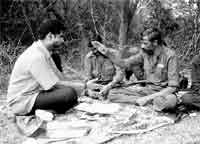Inquiries of a citizen
 Why did you contact Veerappan?
Why did you contact Veerappan?
As a journalist, I saw this as a challenge. The man seemed impossible to trace. Then there were rumours that the villagers were suffering on account of police atrocities. We had been informed that the man had killed 2,000 elephants and looted sandalwood worth over Rs 100 crore. This seemed most improbable. Moreover, more than Rs 150 crore had been spent to catch him. This was the taxpayers' money. I wanted to know whether this money has been wasted. He had killed more than 119 people... a loss to the nation. We also wanted to expose the Jayalalitha government. In April 1993, she informed the state Assembly that Veerappan was in Mumbai. Ten days later, he ambushed a police party and killed 22 police personnel at Palar.
How did you manage to contact Veerappan? And why do you think the government failed to reach him?
Meeting Veerappan took a lot of time and effort. Our first contact was through one of our reporters, Sivasubramanian. Thereafter, we carried several stories on police atrocities in the area where the STF were operating. One had to try several times to meet him. Tribals and informants are sensitive, if they suspect your motives, they will not help you. They were the only link.
As far as the government is concerned, they underestimated him. He knows the jungles like the back of his hand and enjoys the support of majority of the people in the area. The police instead chose to antagonise these people. They alienated the (people, their) only way to get to him.
Do you feel there is a shortcoming in the forest policy that has helped create a brigand like him?
I am not sure of forest policies, but yes, Veerappan received initial encouragement from local MLAs and politicians. The law and order situation needs to be re-examined. Devaram had informed the press that 145 members of the gang had been killed by the STF. That doesn't seem possible. Veerappan says that his gang was never that large. Who were the rest? What was their fault? We know for certain that village youth are used as human shields while looking for him. What tactics are these?
Three years ago Veerappan offered to surrender. He was willing to spend 20 years in prison. But Devaram refused saying that he would rather shoot him. Last year, too, he wanted to surrender, but on condition that the atrocities on villagers stop immediately. No one is justifying him or his actions, but that was one condition.
Did Veerappan share any special information in those meetings?
He told me that his sister had been raped by the DCF Srinivas and that is what incensed him to kill the man. He told me about each of the killings he orchestrated. And he wanted to know why the local people were being harassed. He accepted that he had killed 119 people, but asked the police to own up to the deaths they had caused.
Have you or your publication been under threat? To what extent have you got involved?
After we had met Veerappan twice, the STF had orders to shoot us if we re-entered the forests. We then sent a petition to the Press Council of India. They promptly warned both the state governments not to interfere with our work. We have got involved on humanitarian grounds. Six months ago, three Karnataka STF personnel raped a 12-year-old girl, Nalamma of Nullur village. We have filed a case on this.
